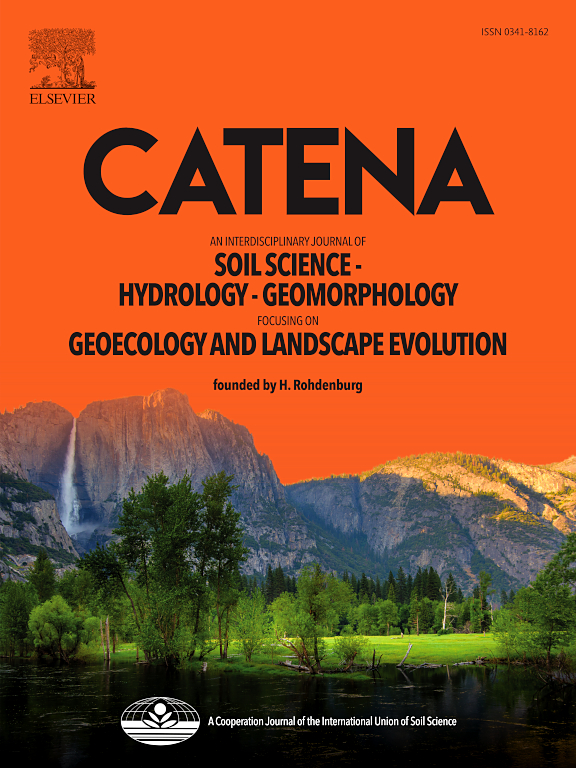IF 5.4
1区 农林科学
Q1 GEOSCIENCES, MULTIDISCIPLINARY
引用次数: 0
摘要
这项研究有助于弥补降雨-径流动态对养分流失的异质时空影响方面的空白。具体目标是揭示不同时间尺度上养分流失对降雨-径流变化的时空响应模式。水土评估工具模型的构建实现了对径流和养分流失的分布式模拟。计算了标准化降水指数(SPI)和标准化溪流指数(SSI),以捕捉不同时间尺度上的降雨-径流动态。通过整合地理和时间加权回归、交叉小波变换和全局空间自相关性,探索了时空响应模式。总体而言,研究结果表明,降雨-径流对养分流失的影响具有明显的空间异质性和时间非平稳性。它们的相关性沿着时空轨迹移动,而不是恒定不变的。从 1990 年到 2020 年,约 60% 的次级流域的 TN 流失呈下降趋势,而 56% 的次级流域的 TP 流失呈上升趋势。SPI/SSI 和 TN/TP 损失的空间异质性随着时间的推移而增加。SPI/SSI 与 TN/TP 损失之间的关系呈现周期性波动。TN/TP 流失量与 SPI/SSI 的总体时空关系在 3 个月时间尺度上通常较高,这表明养分流失量更多地受到当月和前两个月降雨径流累积效应的影响。其中,降雨比径流对养分流失的影响更大。5 月至 10 月的累积降雨主要影响年养分流失量。TN 流失对径流的响应期滞后于降雨,TP 流失对径流的响应期长于 TN。降雨量变化的增加加剧了养分流失的空间异质性,对 TN 的影响大于对 TP 的影响。这项研究加深了人们对降雨-径流与养分流失时空关系的理解。本文章由计算机程序翻译,如有差异,请以英文原文为准。
Spatiotemporal response pattern of nutrient loss to rainfall–runoff dynamics across different timescales
This study contributes to bridging the gaps in heterogeneous spatiotemporal effects of rainfall-runoff dynamics on nutrient loss. The specific aim was to reveal the spatiotemporal response pattern of nutrient loss to rainfall–runoff variations across different timescales. The Soil and Water Assessment Tool model was constructed to achieve distributed simulations of runoff and nutrient loss. The standardized precipitation index (SPI) and standardized streamflow index (SSI) were calculated to capture rainfall-runoff dynamics across different timescales. Spatiotemporal response pattern was explored by integrating the Geographically and Temporally Weighted Regression, Cross Wavelet Transform, and the global spatial autocorrelation. Overall, the findings highlighted obvious spatial heterogeneity and temporal non-stationary of rainfall-runoff effects on nutrient loss. Their correlation shifts along spatiotemporal trajectories rather than constant. From 1990 to 2020, around 60% of sub-watersheds showed decreased trends in TN loss, while 56% experienced increases in TP loss. Spatial heterogeneity in SPI/SSI and TN/TP loss increased with time. Relationships between SPI/SSI and TN/TP loss demonstrated periodic fluctuation. The overall spatiotemporal relations of TN/TP loss with SPI/SSI were generally higher at 3-month timescale, demonstrating nutrient loss is more influenced by the cumulative effects of rainfall-runoff from current month and the two preceding months. Of which, rainfall has stronger effect on nutrient loss than runoff. Cumulative rainfall from May to October primarily influenced annual nutrient loss. The response period of TN loss to runoff lagged behind rainfall, and the response period of TP loss to runoff was longer than TN. Increased rainfall variability intensified spatial heterogeneity in nutrient loss, with a higher effect on TN compared to TP. This study improves the understanding on spatiotemporal relation of rainfall-runoff and nutrient loss.
求助全文
通过发布文献求助,成功后即可免费获取论文全文。
去求助
来源期刊

Catena
环境科学-地球科学综合
CiteScore
10.50
自引率
9.70%
发文量
816
审稿时长
54 days
期刊介绍:
Catena publishes papers describing original field and laboratory investigations and reviews on geoecology and landscape evolution with emphasis on interdisciplinary aspects of soil science, hydrology and geomorphology. It aims to disseminate new knowledge and foster better understanding of the physical environment, of evolutionary sequences that have resulted in past and current landscapes, and of the natural processes that are likely to determine the fate of our terrestrial environment.
Papers within any one of the above topics are welcome provided they are of sufficiently wide interest and relevance.
 求助内容:
求助内容: 应助结果提醒方式:
应助结果提醒方式:


